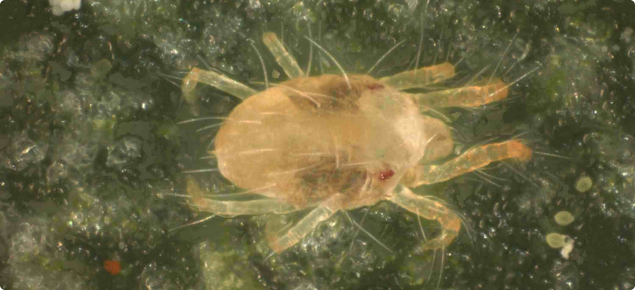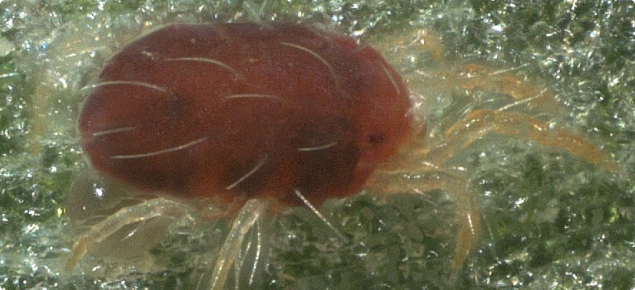Symptoms of mite infestation
Mottled, brown leaves are caused by mites feeding on the undersides of the leaves in low numbers. As infestation builds, the mites move up and infest the whole plant and the characteristic fine webbing is seen.
Plants which have been severely infested are stunted and may die. Damage usually results in lower yields.
Two-spotted mites are very small (0.5mm for females and 0.3mm for males) and a hand lens is required to see them clearly. Adults are yellowish-green with a large dark spot on each side of the abdomen. With the onset of cooler conditions in autumn they become reddish-orange.
Females can lay up to 60 to 70 eggs each. Mite eggs are very small and spherical.
Juveniles hatch 3 to 10 days after laying, depending on the temperature. Juvenile stages of mites are similar in appearance to adults but smaller and lighter in colour. They go through three moults until they become adults. The whole life cycle (egg, larvae, protonymph, deutonymph then adult) can take 9 to 22 days, depending on temperature.
Two-spotted mites are most active during summer when they thrive in the hot dry conditions.
In the cooler months, numbers are low, but during the warmer spring weather numbers can build up rapidly.
Control
Miticides are registered for use in strawberry crops, but should be managed carefully. Repeated applications of the same miticide can result in the development of resistance to the chemical and reduced or no control of the pest.
Biological control using predatory mites is now the main approach used by strawberry growers. Phytoseiulus persimilis is commercially produced in Australia, including Western Australia, and is introduced into strawberry crops for control of two-spotted mite. For more information on the use of beneficials commercially available in Australia see www.dpi.nsw.gov.au/aboutus/resources/bookshop/good-bug-book.
Growers need to ensure that their use of pesticides is compatible with IPM and will not harm the predators. This includes application of pesticides to planting material prior to delivery and to the crop during the season. Growers unsure about the effect of pesticide residues on plants can refer to the side effects manuals for information that is updated regularly.
Cultural control techniques can also be used in managing mites. This includes keeping plants healthy so they can tolerate larger populations with less damage. Mowing or removing weeds helps minimise pest infestation.
Treating infested runners may prevent early infestation, but you will need to check with runner producers what pesticides have been applied to the runners, and when, as this may affect your treatment options and delay the ability to apply predators.



